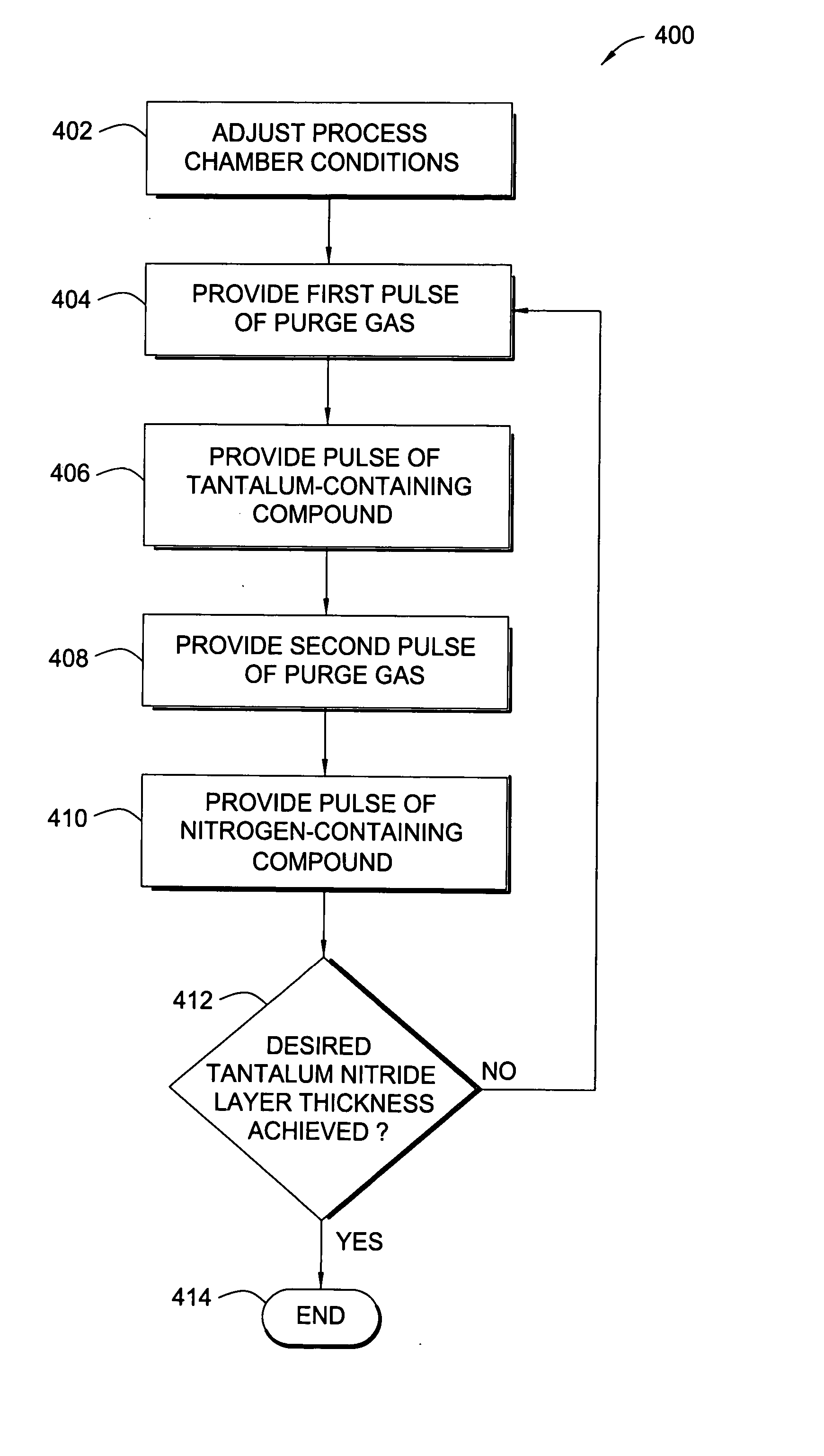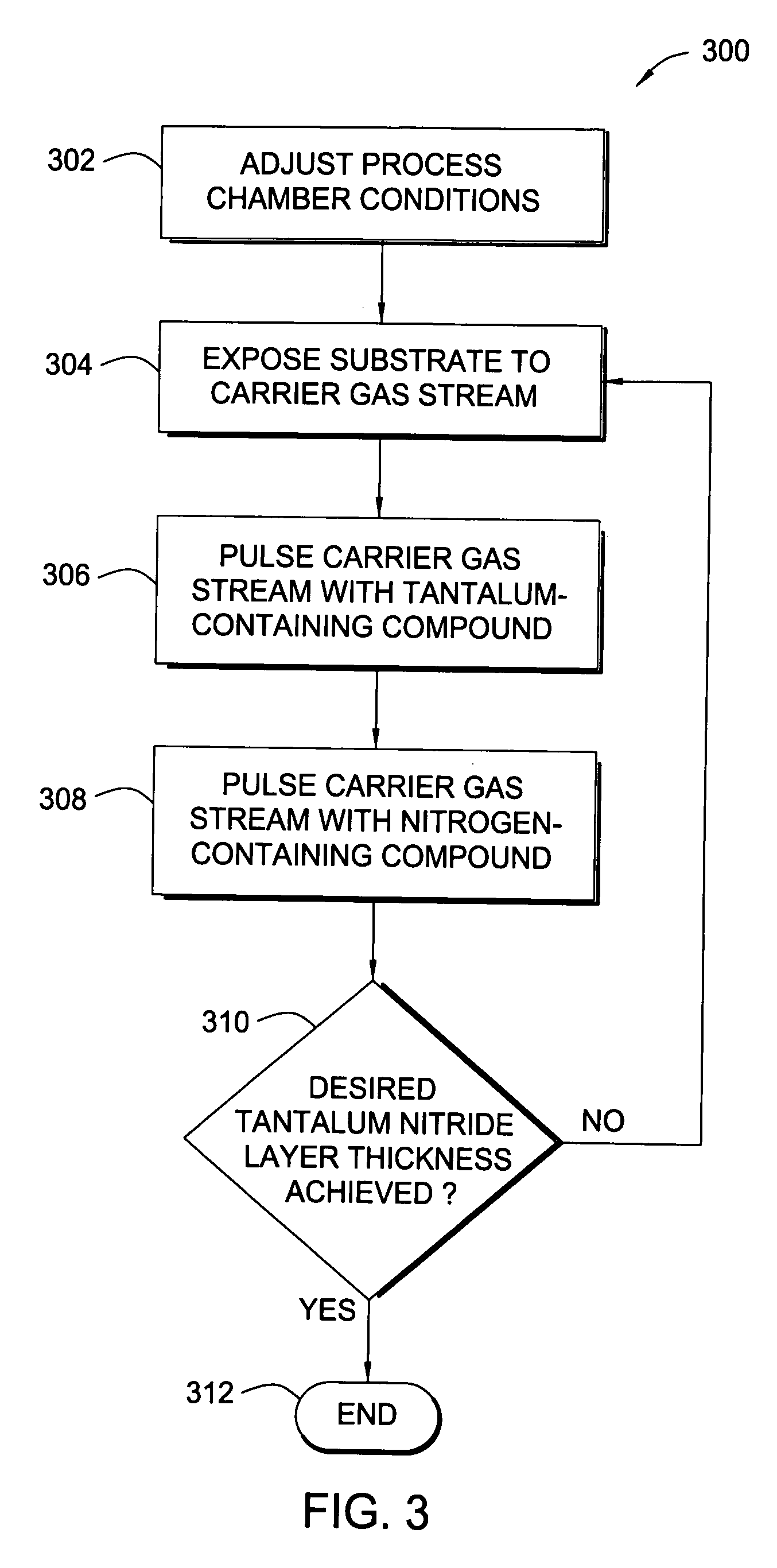Atomic layer deposition of tantalum-containing materials using the tantalum precursor taimata
a technology of tantalum precursor and atomic layer, applied in the direction of chemical vapor deposition coating, coating, semiconductor devices, etc., can solve the problems of ultimate device failure, dielectric layer to become conductive, and diffusion into neighboring layers
- Summary
- Abstract
- Description
- Claims
- Application Information
AI Technical Summary
Benefits of technology
Problems solved by technology
Method used
Image
Examples
example 1
[0055] A tantalum-containing material is deposited on a substrate surface containing a dielectric material by an ALD process using TAIMATA as described herein to a thickness in a range from about 5 Å to about 30 Å, preferably about 20 Å. Copper metal is deposited on the tantalum-containing material, such as by a PVD process to a thickness in a range from about 200 Å to about 1,500 Å, preferably about 500 Å. Subsequently, the copper layer may be exposed to an electrochemical polishing (ECP) process.
example 2
[0056] A tantalum-containing material is deposited on a substrate surface containing a dielectric material by an ALD process using TAIMATA as described herein to a thickness in a range from about 5 Å to about 50 Å, preferably about 20 Å. Tantalum metal is deposited on the tantalum-containing material by a PVD process or by an ALD process using TAIMATA described herein to a thickness in a range from about 5 Å to about 75 Å, preferably about 25 Å. The substrate is exposed to a plasma etch process to remove materials from the bottom of the via to a depth in a range from about 5 Å to about 100 Å, preferably about 50 Å. Next, a tantalum metal is deposited by a PVD process or by an ALD process using TAIMATA described herein to a thickness in a range from about 5 Å to about 75 Å, preferably about 25 Å. Copper metal is then deposited on the tantalum metal, such as by a PVD process to a thickness in a range from about 200 Å to about 1,500 Å, preferably about 500 Å. Subsequently, the copper l...
example 3
[0057] A tantalum-containing material is deposited on a substrate surface containing a dielectric material by an ALD process using TAIMATA as described herein to a thickness in a range from about 5 Å to about 50 Å, preferably about 20 Å. The substrate is exposed to a plasma etch process to remove materials from the bottom of the via to a depth in a range from about 5 Å to about 75 Å, preferably about 20 Å. Next, a tantalum metal is deposited by a PVD process or by an ALD process using TAIMATA as described herein to a thickness in a range from about 5 Å to about 75 Å,preferably about 25 Å. Copper metal is then deposited on the tantalum metal, such as by a PVD process to a thickness in a range from about 200 Å to about 1,500 Å, preferably about 500 Å. Subsequently, the copper layer may be exposed to an ECP process.
PUM
| Property | Measurement | Unit |
|---|---|---|
| temperature | aaaaa | aaaaa |
| temperature | aaaaa | aaaaa |
| size | aaaaa | aaaaa |
Abstract
Description
Claims
Application Information
 Login to View More
Login to View More - R&D
- Intellectual Property
- Life Sciences
- Materials
- Tech Scout
- Unparalleled Data Quality
- Higher Quality Content
- 60% Fewer Hallucinations
Browse by: Latest US Patents, China's latest patents, Technical Efficacy Thesaurus, Application Domain, Technology Topic, Popular Technical Reports.
© 2025 PatSnap. All rights reserved.Legal|Privacy policy|Modern Slavery Act Transparency Statement|Sitemap|About US| Contact US: help@patsnap.com



